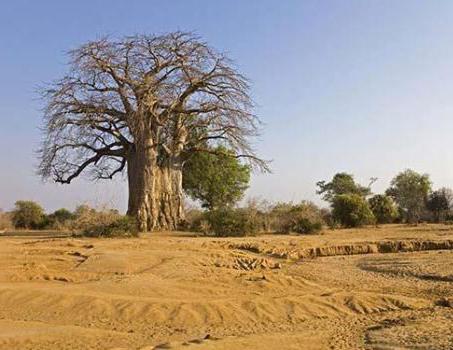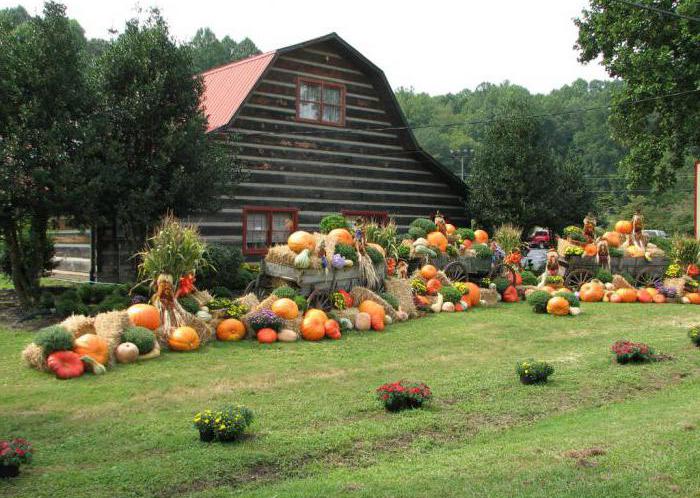Savannah: soil, vegetation and animals. Which soils prevail in the savannah?
Savannah is a natural zone with a predominancegrassy vegetation on red lateritic soils. This zone natural complex (PC) is distributed between moist forests and semi-deserts. Over 40% of the area of Africa occupy vast expanses of savannah. Soils of reddish color are formed under high-grass vegetation with predominance of cereals, rare specimens of trees and bushes.
The tropical forest-steppe
Savannah, except Africa, is common in Australiaand on the Hindustan Peninsula. This type of PC includes campos and Llanos on the mainland of South America. Often a savannah is compared with the forest-steppe of the temperate belt of Eurasia. There are some similarities, but there are more differences. The main features that characterize savannahs are:
- soils with low humus content;
- grassy xeromorphic vegetation;
- trees and shrubs with an umbellate crown;
- a rich and diverse fauna (in contrast to the steppes, it is preserved).

Campos - Savannah in the Brazilian Plateau -is formed by different types of plant communities. Serrados is characterized by the presence of undersized trees and shrubs. Limpos forms a high-grass steppe. Llanos on both sides of the Orinoco River in South America are covered with thick grass and separate groups of trees (palm trees).
African Savannah. Soil and climate
The zone of the tropical forest-steppe occupies on the hot continent about 40% of the territory.
In the Northern Hemisphere, savannahs reachsemi-deserts at a latitude of 16-18 °, are close to Lake Chad and the sands of the Sahara. The boundary of the distribution of this zonal PC in the south is the Southern Tropic. Savannahs occupy flat areas and rise to a considerable height within the East African plateau.
The predominant types of climate are subequatorial andtropical. Well-defined within a year two seasons - wet and dry. The rainy season is shortened when moving from the equator to the tropics from 7-9 to 3-4 months. In January, when the wet season begins in the Northern Hemisphere, the Southern Hemisphere begins arid. The total amount of moisture reaches 800-1200 mm / year. Humidity coefficient - less than 1 (not enough precipitation). Individual sites suffer from a meager supply of moisture (Kulus below 0.5-0.3).
What kind of soil in the savanna is formed in suchclimatic conditions? During the rainy season, nutrients are washed intensively by water into the lower horizons. When the dry period comes, the reverse phenomenon is observed - the soil solutions are rising.

Type of vegetation and climate
Having received moisture, the tropical forest-steppe in Africacomes to life. Yellow-brown shades of dry stems are replaced by emerald greens. The leaves grow on those trees and bushes that the foliage has dropped during a drought, the grasses are rapidly stretching, sometimes reaching 3 m in height. Soil-flora and fauna of the savannah of Africa is formed under the influence of climate. Temperature conditions and humidification depend on the geographical location of the site.
Closer to the border of the equatorial forests is the rainy seasonlasts about 9 months. Here a tall grass savanna is formed; groups of trees and shrubs are more numerous. There are mimosa and palm trees, forming gallery valleys along river valleys. The most interesting representative of the plant kingdom of the savannah is the baobab. The trunk of the tree often reaches 45 m in the girth.
As you move away from the equator and approachtropics, the rainy season is declining, typical savannahs are developing. Border with semi-deserts the territory receives moisture 3 months a year. Vegetation, which is formed in arid conditions, refers to the desert type of savannah. At 50 ° C it differs little from the desert. The North African peoples call these natural areas "sahel", the inhabitants of South Africa - "bush".

Which soils prevail in the savanna
The soil of the tropical forest-steppe is red-browncolor, which give it iron compounds. This type is characterized by a low content of humus - from 1.5 to 3%. The middle part of the profile contains clays, in the lower one is an illuvial-carbonate soil horizon. The above features are typical for East Africa, the northern part of the Australian continent and individual regions of South America.
What kind of soil in the savanna is formed depends ontype humidification. With a sufficiently long dry period, humus accumulates due to the gradual decomposition of vegetation. More fertile soils in the dry savannah of Africa and the steppes of South America. With regular moistening, a granular structure or a shell is formed on the surface of the earth (hard crust).

Types of soil
Within a single natural zone, a differentthe amount of precipitation, the duration of dry periods differ. The features of the relief and climatic conditions impose an imprint on the type of vegetation of the savannah. Soils are formed by the interaction of all elements of the natural complex. For example, plant residues in the wet forest zone do not have time to decompose, nutrients are washed out by abundant precipitation.
Compared with the red-yellow ferraliteThe soil of the forests of the equatorial belt in savannahs accumulates more humus. Due to the dry period, there is a slow decomposition of plant residues and the formation of humus. Intermediate type - red ferralite substrates of variable-moist forests. Under the cereal savannas are mainly located lateritic and reddish-brown soils. Black soil is formed under the dry type of this natural zone. As they approach the desert regions, they are replaced by reddish-brown soils. Brightly-brownish or brick-red coloring the soil acquires due to accumulations of iron ions.

Wildlife Savannah
Surprisingly rich and diverse faunatropical forest-steppe. There are representatives of all groups of animals. Spiders, scorpions, snakes, elephants, hippos, rhinoceroses, wild boars find food in the savanna, shelter from the heat of the day or rain. Everywhere there are earthen cones of termite structures that revitalize the flat surface of the savannah. Soils are inhabited by spiders and small rodents, in the grass there are constant rustling sounds - snakes and other reptiles scurry. Large predators - lions, tigers - deftly hide in high grass to attack the victim unexpectedly.
Ostriches behave carefully: high growth and a long neck allow a massive bird to notice the danger in time and hide the head. Most savanna inhabitants flee from predators. Overwhelmed by considerable distance are ungulate herbivores: zebras, gazelles, antelopes, buffaloes. Giraffes elegantly eat delicate foliage in the highest trees, and on the shore of lakes in the thickets of grass turn awkward hippos.

Agriculture in the savannah and woodlands
Significant areas of the tropical forest-steppeAustralia and South America are engaged in pasture and growing cotton, corn, peanuts. The agriculture of India and Africa also uses savannahs and woodlands. Soils of red-brown color are fertile when moistened and properly processed. The low crop culture and lack of reclamation led to the development of erosion processes. The Sahel zone in Africa is a territory of modern desertification, caused by a combination of natural and anthropogenic factors.

Problems of preserving the soil of the savannah
The nature of Africa is changing under the influence ofa man: the forests are cut down, the savannah is plowed up. Vegetation and animals are adversely affected by the anthropogenic factor. The number of predators and ungulates is decreasing, the population of primates is under threat. Violation of the vegetation cover during plowing of savannah or deforestation leads to rapid destruction of the soil. Downpours erode the upper fertile layer, reveals a dense mass of clay and iron compounds. It is cemented under the influence of high air temperatures. Such phenomena occur in areas of intensive farming and grazing. Red-brown soils of savannahs need protection and restoration in huge areas in the developing states of Africa and Latin America.






